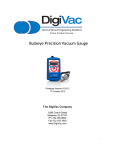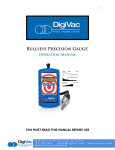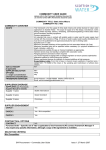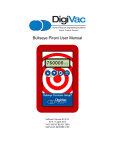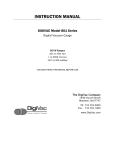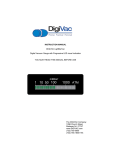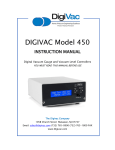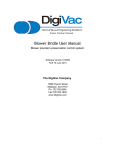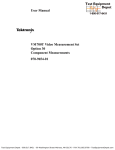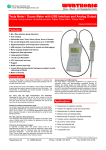Download Bullseye Vacuum Gauge
Transcript
Bullseye Vacuum Gauge . Version K14B05 5 February 2014 YOU MUST READ THIS MANUAL BEFORE USE The Chemtech Company 4844249415 www.chemtechsci.com 1 Table of Contents Overview Quick Start Modes of Display Display Large numbers Display Bar graph Display Pumpdown graph Display Line graph Menu of Settings Display Numeric format High Resolution Low Resolution Scientific Setpoint value Setpoint action Pumpdown time AutoOff time Sound Self Test Measurement Units Units pumpdown rate Calibration Version Auto Off Operation Set Point Operation Vacuum System Analysis Data set size Differential Analysis Reset Self Test Operation Field Calibration Calibration parameters Calibration functions Functions F/ATM, F/MID and F/VAC Functions F/LOAD and F/STORE Calibrating the instrument UNDERSTANDING TORR 2 SERVICING AND MAINTENANCE GAUGE TUBE SERVICING Maintenance FACTORY REPAIR AND CALIBRATION NOTES ON CALIBRATION Instrument Accuracy SPECIFICATIONS Terms and Conditions 3 Overview The Bullseye Precision Gauge is a rugged, portable vacuum measurement instrument designed specifically for the demands of field use. First and foremost, it is a highly accurate vacuum gauge using field proven thermocouple vacuum sensor technology. The Bullseye Precision Gauge offers several viewing options including numeric, bar graph, line graph and pumpdown graph display. Portable ● Rugged design that offers a superstrong magnet for handsfree vacuum measurement ● Field proven thermocouple vacuum sensing technology Precise ● Bullseye accuracy available in 12 different measurement units ● Field calibratable Reliable ● 70 hour battery life ● Protective rubber boot ● Simple easy to use design Features: ● Auto Off ● On/Off soft switch ● Battery level indication ● Good/Bad sensor (tube) indication ● 70 hour battery life ● Self test mode ● Field replaceable sensor ● 3 different graphical displays of vacuum pressure ● Vacuum analytics for leak, outgassing and pump down ● Available with hard or soft protective travel cases 4 Quick Start for Chemtech’s Bullseye Precision Gauge While this vacuum instrument has many features, it is very simple to use. First unpack the gauge to verify you’ve received everything you ordered. Easy to use steps: 1. Remove protective boot. 2. Remove the battery cover and install 4 AA batteries 3. Plumb the thermocouple sensor into the system to be measured, taking care to keep the stem down 4. Power on the device by pressing the “PWR” button. It will take about 5 seconds to turn on. 5. If need be, turn on the backlight. The backlight does not affect gauge reading or accuracy 6. Read vacuum! Feel free to explore the latest copy of this manual at www.Chemtechsci.com for all the features that make this a truly useful tool. 5 6 Modes of Display The Bullseye Precision Gauge has four display modes: one numeric, and three graphical. The numeric display has three numeric formats: Low Resolution, High Resolution, and Scientific Notation. Display modes are selected from the settings menu “Display”, and numeric formats are selected from the Setting option “display”. The SEL button enters and traverses the Settings menu. Display Large number The following example shows the numeric display with the “High Resolution” format. The following image shows the Large number display with the “Scientific” format. The numeric display shows the currently configured units, in these examples the vacuum pressure units are “microns” or “torr”. Below the units indicator are the battery, vacuum pressure, and vacuum system analysis indicators. In any display mode, the UP and DOWN buttons turn the backlight on and off (respectively), the SEL button enters the configuration menu, and the ENT button turns the gauge on or off. 7 In the previous example the battery indicator is shown at full strength and the vacuum pressure indicator is shown in its second of three (logarithmic / order of magnitude) levels. The following example shows the numeric display when the vacuum sensor tube is disconnected, failed or when an overrange condition exists (pressure above 1000 Torr). Display Bar Graph The bar graph visualizes the current sensor reading with a stepped bar. Display Pump-down graph The pumpdown graph plots time horizontally and log pressure vertically. The horizontal time scale is selected using the configuration option “Pumpdown time”. The vertical pressure scale is logarithmic, indicating order of magnitude from one micron to atmosphere. 8 In the top left is the current vacuum pressure display figure. In the center of the first line is the Vacuum System Analysis, “PUMP”, and to the right is one of either the pump down rate in units per minute, or the data set window size in hours, minutes and seconds. The “STABLE” case shows data set window size (for example “1m18s”). Display Line graph The autoscaling (or, autoranging) time graph is a microscope into the pump down data. In this mode, the pump down graph is shown with a linear pressure scale that is fit to the pressure range of the data set. The height of the graph display is the pressure range of the data set in a linear scale (not log). The top left figure is the maximum value in this range, and the bottom left figure is the minimum value in this range. The top right figure is the current or most recent value in the instrument. Sometimes this visualization is not useful, showing noise. This noise comes from the from the instrument’s process of measurement, as well as the vacuum system under measurement. In this sense, the auto scaling line graph is a data visualization microscope. Quick Tip : This visualization can show a very small climbing or descending trend that the vacuum analysis algorithm has not declared as a leak or pumping. 9 Menu of Settings Display Pressing the SEL button from the vacuum display screen will present three submenus: Display, Calibration and Setpoints. The settings menu is a linear series of menu options that are stepped or skipped through using the SEL button. Above each button is a utility hint to indicate specific button function. The SKIP hint is above the SEL button to indicate that the SEL button is used to step or skip to the next menu screen with no configuration change. The ENTER hint above the ENT button indicates that this button is used to enter the display mode as shown in the menu screen. Using the UP or DOWN buttons will change the option available on the menu screen. In the example above, the configuration menu is ready to change the display to the Pumpdown Graph. In this state pressing the ENTER button will change the display to the Pumpdown Graph, or pressing the SKIP button will ignore the state of the menu screen and leave the display mode unchanged. Number format The number format setting defines the vacuum pressure number format throughout all modes of display. The UP and DOWN buttons select a format type from “High Resolution”, “Scientific” and “Low Resolution”, and the ENT button saves the current choice. 10 High Resolution The High Resolution format has three digits of precision. For example, an internal vacuum value of 1234 microns (µm Hg) would be displayed as 1.23 torr in the Precision numeric format with torr units. Additionally, this format gives the raw vacuum measurement data which may be useful for trending, but may result in a noisier reading. Low Resolution The Low Resolution format has two digits of precision. For example, an internal vacuum value of 1234 microns (µm Hg) would be displayed as 1.2 torr in the Low Resolution numeric format with torr units. This number format also gives a filtered number depending on the accuracy of the gauge in the pressure range of measurement. For example, it may count by 50 Torr around 100 Torr since the accuracy in this range is +/ 50 Torr, which results in a ‘quieter’ gauge. Scientific The scientific format has two digits of precision with a base ten exponent following conventional usage. For example, an internal vacuum value of 1234 microns (µm Hg) would be displayed as 0 1.2 x 10 torr. For any resolution below 2 millitorr, the scientific format must be used. Setpoint value The Set Point Value is defined in terms of the current vacuum pressure units. The Set Point indicates a pump down to configured pressure state according to the setting of the Set Point Action. See “Set Point Operation” for more detail. Setpoint action The Set Point Action is defined as one of a set of choices, including: None, Beep, Beep and Flash, or Flash. For details of operation, refer to the section “Set Point Operation”. Pumpdown time The pumpdown time configuration option defines the width of the Pumpdown Graph and 11 pumpdown rate window. The pumpdown rate is the difference between the start and end of the pressure data shown in the pumpdown graph. For example using a pump down time of ten minutes, a system pump down from atmospheric pressure to one torr in ten minutes has a pump down rate of 760 torr per ten minutes or 76 torr per minute. Auto Off time Use this setting to save battery power during periods of inactivity. The figure zero will disable the auto off battery saver feature. To see the specifics of this feature, look at the Auto Off Operation section. With a positive (non zero) value, the unit will indicate the Auto Off Backlight time Use this setting to save battery power during periods of inactivity. The figure zero will never turn off the backlight. Setting the Backlight time to some number of minutes means the backlight will turn off after that number of minutes. Sound The two sound configurations determine the audible Set Point Alarm and Calibration Storage Acknowledgement tones, named “Sound SP” and “Sound Cal” respectively. The Set Point Alarm sound is typically configured to a different value from the Calibration Acknowledgement sound. Self Test The self test function reviews the Tube and Battery status, and resets the internal Elapsed Time Clock, Pump Down Data, and Auto Off subsystems. 12 Enter the Self Test sequence with this option. Refer to the section “Self Test Operation” for more detail. Measurement Units The units settings permits numeric vacuum values to be displayed in any one of a 12 available vacuum pressure units including microns, millitorr, millimeters of mercury, Torr, mbar, Bar, Pa, kPa, inches of mercury, mm of water, inches of water and PSIA. Note that inches of mercury and inches of water is zero referenced to 760 Torr absolute pressure. Quick Note : A negative number indicates vacuum, a positive number indicates pressure relative to sea level. Units pumpdown rate The units pumpdown configuration option permits the pumpdown rate figure displayed in the Pumpdown Graph to employ identical or different units from the numeric vacuum units. Use this option to change the pumpdown rate units. This option has been included to support work with multiple sources of technical documentation for the vacuum system, and vacuum system pump down. The “Sync” option, shown in this example (above), maintains the pumpdown rate units as identical to the primary vacuum units. Of course this is the recommended configuration, as employing mixed units could be a source of misunderstanding. Calibration This configuration option is available from the main menu and will enter the field calibration mode. 13 Refer to the section “Field Calibration” for a complete description of the operation of the Calibration function. Version The last step in the configuration menu reports the software version identifier. This software version identifier is useful for communicating with the factory or distributor support. Factory Defaults The last step in the settings screen will return all the settings to factory defaults. This does not affect calibration. Tap the “reset” button to restore factory Auto Off Operation The auto off feature has been defined as an unattended mode of operation to not conflict with other unattended modes of operation. The Bullseye Precision Gauge will not turn itself off when: ● connected to a system under vacuum (less than 100 Torr, pump down feature set) ● initially filling the pump down data set (pump down feature set) ● not timedout since pump down or button activity ● in calibration mode Set Point Operation A Set Point may be defined to beep (configured sound) or flash (invert display) when a low pressure vacuum has been achieved. The Set Point Value is defined with the Configuration option “Set point V units” for V between one micron and atmosphere. The Set Point Action is defined with the Configuration option “Set point A” for A one of “None”, “Beep”, “Flash”, “Beep&Flash”. The Set Point Alarm is raised on successfully achieving the objective vacuum pressure (Set Point Value). The Set Point Alarm is lowered, but not cleared, on pressing any button while the alarm is raised (display flashing or beep sounding). The Set Point Alarm is cleared, and is ready to be raised again, when the pressure in the 14 system under test rises well above the Setpoint Value. Vacuum System Analysis The result of the Vacuum System Analysis is one of “PUMP”, “LEAK”, “OUTGAS” or “STABLE” and is shown in some display modes. Internally, one data set serves the Pump down and Time Auto line graphs as well as the Vacuum System Analysis. The data is visualized in the Pump down and Time Auto line graphs. The data set is maintained continuously in every mode of operation. Data set size The width of the data set in time is configured with the option “Pumpdown time”. This figure is employed to determine the time slices that are accumulated at a rate of roughly three updates per second. A small difference will accrue to the actual data set span in hours, minutes, and seconds. The Pump down graph with a “STABLE” case (under 100 torr) will display the actual time window size in hours, minutes and seconds. Differential Analysis The Vacuum System Analysis looks at the last quarter of the pump down data set to determine the state of the system under test. The whole analysis is recomputed approximately three times per second. The “LEAK” result indicates pressure increasing towards atmosphere with rates that are not typically indicative of outgassing alone. The “PUMP” result indicates a strong pressure descent to vacuum as for a system under vacuum pump down. The “OUTGAS” result indicates evidence of outgassing. Evidence of outgassing is a pressure trend that is ascending at a rate that is decreasing. Eventually the rate of ascent decreases until the pressure stabilizes. The “STABLE” result indicates no particular evidence of venting (LEAK) or outgassing, and is shown for slow pump down rates for the benefit of the experience of working with the instrument. The “STABLE” case partially obscures some (weak) “PUMP” cases in order to stabilize the instrument display. Reset The pump down data set is cleared in poweroff states: turned off, or dead or missing batteries. 15 Self Test Operation The Self Test feature is available from the Configuration option “Self Test”, pictured below. From this Configuration option, press the ENT button to enter the Self Test sequence. The Self Test sequence proceeds on any button press through a set of steps. The first step in the Self Test sequence, shown below, performs tests of the Battery level and Tube connection. Pressing any button will increment the Self Test sequence to the second step, shown below. The second step reviews the detailed results of the tests performed in the preceding step. Pressing any button will proceed to the third step. The third step reports the overall condition as GOOD or NOT GOOD, based on the results reviewed in the previous step. Pressing any button will exit the Self Test and reset the Elapsed Time Clock and dependent subsystems including the Pump Down Data Set as occurs on any power off state (turned off or batteries dead or missing). 16 Field Calibration From the Settings view, choose “Calibration”, pictured below, press the ENT button to enter the field calibration mode. The field calibration mode, shown below, shows digital signal counts and torr pressure times +4 +4 10,000 (“Torr x 10 ”). For example, one micron (or millitorr) is “10” in the “Torr x 10 ” scale. Calibration parameters The calibration method employs a “zero, mid and span” model. The “ATM” parameter is modified to align to 760 torr , and the “VAC” parameter is modified to align to 5 millitorr . In the +4 “Torr x 10” scale employed in the Calibration mode, these pressures are represented with the figures 7600000 and 50 , respectively. Calibration functions The Calibration mode operates using a function concept. The current function is one of eight available functions (operations) and is shown above the EXIT button hint as “F/LOAD” in this example. The four functions are F/LOAD, F/STORE, F/ATM, F/MID, F/VAC, F/2T, F/700T, and F/2mT. The SEL button changes the current function among these four possibilities. Functions F/ATM, F/MID and F/VAC The F/ATM and F/VAC functions enable the UP and DOWN buttons to change these parameter values. As these parameter values change, the internal pressure value register shown in the +4 Calibration display (at “Torr x 10 ”) is modified. Quick Note : These values are not saved for use beyond the calibration session until they are stored using F/STORE. Functions F/2T, F/700T, and F/2mT The F/2T, F/700T and F/2mT is a calibration shortcut. When in the function mode F/2T, when the vacuum in the manifold is exactly 2 Torr against a known standard, press the UP and DOWN buttons simultaneously to adjust the MID calibration point to the correct value. In a similar way, F/700T and F/2mT is used. 17 Functions F/LOAD and F/STORE The F/LOAD and F/STORE functions read and write parameters from and to persistent memory (long term storage). One of these two functions is available when the function indicator above the EXIT hint shows F/LOAD or F/STORE. In this case, pressing and releasing the UP and DOWN buttons together will execute the function. When the function has been successfully executed the display will flash, and an audible beep will sound (with the tone configured in “Sound Cal”). Quick Note : Completing a calibration session requires execution of F/STORE in order to save the parameters to persistent memory before exiting. Exiting a calibration session without successfully executing the F/STORE function will discard the calibration parameters. Calibrating the instrument Note: Calibration always happens in Torr measurement units. 1. Set Cal points VAC, MID and ATM to zero a. A shortcut for setting a variable to zero is to set the unit to the desired variable, such as F/VAC b. Press the UP and DOWN buttons together. That variable will now be zeroed. 2. Set the manifold to exactly 2 Torr according to a known standard, then set the “F/MID” such that the unit reads exactly 2 Torr, or “2000 0” a. A shortcut for setting the MID is to change the function to “F/2T” b. Then press the UP and DOWN buttons together. This will optimally set the MID calibration point. 3. Set manifold vacuum to 760 Torr, and adjust "ATM" so the Bullseye Precision Gauge reading reflects Standard +/ 10 Torr a. A shortcut for setting the ATM is to change the function to “F/700”, and set the manifold to 700 Torr b. Then press the UP and DOWN buttons together. This will optimally set the ATM calibration point. 4. Set manifold vacuum to .005 Torr, and adjust "VAC" so the Bullseye Precision Gauge reading reflects standard +/ 0.001 Torr a. A shortcut for setting the VAC is to change the function to “F/2mT”, and set the manifold to 2 millitorr. b. Then press the UP and DOWN buttons together. This will optimally set the VAC calibration point. 5. Store 6. Check ATM is +/ 20 Torr 7. Check Vac is +/ 0.002 Torr 8. For calibrating unit for repeatable sub millitorr readings, calibrate 2 millitorr at the ambient temperature at which you will be using the gauge. Let the vacuum system sit at 18 2 millitorr for 10 minutes, then calibrate. The settle time for an accurate reading below 1 millitorr is approximately 2 minutes. UNDERSTANDING TORR This instrument and many similar instruments are calibrated in microns or "milliTorr." It is appropriate to discuss what microns are and to relate microns to other measures of pressure and vacuum. Microns are not really a measure of vacuum at all, but rather of absolute pressure. It will be recalled that the pressure of the atmosphere is 14.696 or approximately 14.7 pounds per square inch at sea level. This pressure is due to the weight of all of the air in the earth's atmosphere above any particular square inch. This 14.696 PSI is equivalent to the pressure produced by a mercury column of approximately 29.92 inches high or .76 meters (about 3/4 of a yard) or 760 millimeters of mercury. Atmospheric pressure varies greatly with altitude. It decreases approximately 1 inch of mercury per thousand feet of altitude. It also varies widely with local weather conditions. (Variations of one half inch in a single day are common.) The word vacuum means pressure lower than atmospheric or "suction," but, in describing negative pressure, the atmosphere is only a satisfactory reference if we are dealing with values of vacuum down to about 27 inches of mercury. Below that, it is much more useful to talk in terms of absolute pressure, starting from absolute zero. The Bullseye Precision Gauge and all similar instruments do just this. One TORR, a commonly used unit, is an absolute pressure of one millimeter of mercury. A milliTorr is equal to one thousandth of a TORR. A MICRON is the same as a milliTorr. 19 SERVICING AND MAINTENANCE GAUGE TUBE SERVICING In many cases, a gauge tube may become fouled with oil or other foreign matter. It is often possible to restore the functionality of contaminated probes with cleaning. If the contaminant is known, the tube should be filled with a fluid that is known to be a solvent to that contaminant. As an example, ether is often effective in removing residues of some oils. Commercial carburetor cleaners are very powerful solvents and are highly effective against some contaminants. After cleaning with solvents, the gauge tube should be completely dried or flushed with a volatile solvent to assure that it is dry prior to reinstalling it. If this is not done, contamination of the system may result. Maintenance Your vacuum instrument should give you many years of trouble free service. There are no regularly scheduled maintenance intervals. If consistent accuracy is required, it is recommended that the gauge, tube, cable and power supply be returned for a yearly calibration check. FACTORY REPAIR AND CALIBRATION The vacuum gauge assembly is designed to provide years of troublefree service, and the liberal internal use of plugin components make it easily repairable. NOTES ON CALIBRATION The instrument is calibrated in nitrogen, which has thermal properties virtually identical to air. Other gasses will affect the readings by an amount proportional to the thermal conductivity of the gases. In most cases, the gases present in a vacuum system will be air, nitrogen, or oxygen, and no appreciable errors will occur. Certain other gases, however, have thermal conductivity significantly greater than air and will cause the instrument to read higher than the actual amount of pressure. Examples of such gases are water vapor, fluorocarbon refrigerants, and acetone. Conversely, other gasses have thermal conductivity significantly lower than air and will cause the instrument to read lower than actual pressure. Examples of such gases include helium, oxygen and to a lesser extent, CO2. When interpreting readings using gasses other than air, it should be borne in mind that the Bullseye Precision Gauge reads Torr, which is a measure of absolute pressure that is the opposite of vacuum. Thus, a lower numerical reading actually is a higher level of vacuum. For more information, refer to section 8.0. 20 Instrument repeatable Accuracy .001 to .010 Torr +/ .002 Torr .010 to 10 Torr +/ 20% of reading 10 to 300 Torr In range (5, 300 Torr), increasing pressure results in increasing value 300 to 800 Torr +/ 20% of reading Instrument Accuracy with random tube Assume replacement Tube is the same type from the same manufacturer, MID and VAC set to zero, ATM rough calibrated to 760 when tube exposed to ATM .001 to .030 Torr +/ .015 Torr .030 to 1.00 Torr +/ 30% of reading 1.00 to 300 Torr In range (1, 300 Torr), increasing pressure results in increasing value 300 to 800Torr +/ 30% of reading SPECIFICATIONS Time to resolve 2 seconds to decade, 20 seconds to full accuracy Input Voltage 4 AA Alkaline Maintenance Interval 110 years depending on use Overall Dimensions, front panel 6.0 in high, 3.5 in wide, 1.25 inches deep 21 Ambient Operating range 40°F to 120°F Battery Life 60 Hours running Measurement Media Clean Dry Air or Nitrogen Certifications, controller display CE Planned Shipping Bill of Materials The vacuum instrument contains the following components: 1. Vacuum Instrument with amber backlight and blue rubber boot attached to 7’ of coiled cable with Octal 2. Thermocouple Plus vacuum sensor, part number SENVGT500 3. Quick Start guide or (this) User Manual 22 TERMS OF USE, LIMITED WARRANTY & LIABILITY WAIVER THE Chemtech COMPANY (“Chemtech”) offers all of its products with the following terms and conditions and notices as follows. By accepting and/or using a Chemtech product, you hereby acknowledge and agree to the following terms and conditions, and acceptance of these terms and conditions are a condition precedent to any purchase/sale agreement between you and Chemtech. Exclusive Obligation: The Chemtech product you are purchasing has been designed for a specific use within a set of suitable operating conditions, as set forth in its User Manual, or as indicated otherwise by Chemtech. Any use of the Chemtech Product for any purpose or under any conditions, other than those specified, shall render any limited warranty void, and shall expressly invalidate any liability of Chemtech for damages as a result of such misuse. UseR limitation: You may not modify, copy, distribute, transmit, display, perform, reproduce, publish, license, create derivative works from, transfer, or sell, any information, software, products or services obtained from or created by Chemtech to any third party, without the express written consent of Chemtech to do otherwise. Any violation of this provision shall give rise to an indemnification of Chemtech by you, for any third party claims arising out of such violation. THIRTY (30) DAY LIMITED Warranty: All Chemtech products are warranted against any manufactured defect for a period of thirty (30) days from date of purchase, unless such product is a customwork for you and not a standard Chemtech product. Any product qualifying as a customwork shall not be warranted against any defects for any purpose, and your acceptance of such customwork shall relieve Chemtech of any liability for any purpose. WITH THE EXCEPTION OF THE LIMITED WARRRANTY ABOVE, YOU AGREE ANY Chemtech PRODUCT IS PROVIDED AS IS, EXCLUSIVE OF ANY WARRANTY, INCLUDING, WITHOUT LIMITATION, ANY IMPLIED WARRANTY OF MERCHANTABILITY, FITNESS FOR A PARTICULAR PURPOSE, NONINFRINGEMENT, OR ANY OTHER WARRANTY, EXPRESSED OR IMPLIED. Limitation Of Liability: You agree and acknowledge, Chemtech shall have no liability to you whatsoever for any direct, indirect, punitive, incidental, special consequential damages arising out of or connected with the use or misuse of its products. In particular, given the nature of Chemtech products, you agree and acknowledge, under no circumstances whatsoever shall Chemtech be liable to you for any consequential damages for damage to any nonChemtech product or service, arising from the failure, use or misuse of a Chemtech product, including, but not limited to, any vacuum system, engine, vehicle, factory, or the like. In the event, a court of law with proper jurisdiction finds Chemtech liable to you for any purpose, you agree and acknowledge Chemtech’s maximum liability shall not exceed the purchase price of one unit of product giving rise to such liability, or $250.00, whichever is greater. Entire Obligation: These terms and conditions express the entire obligation of Chemtech with respect to its products. If any part of these terms and conditions are deemed void, invalid, unenforceable or illegal, including, but not limited to, the warranty disclaimers, liability disclaimers and liability limitations set forth above, then the unenforceable clause or sentence may be disregarded with the remainder of these terms and conditions valid and enforced. In the event the unenforceable clause or sentence leaves a void in these terms and conditions, a provision closely matching the intent of the unenforceable provision should be deemed inherent within these terms and conditions, slightly modified to render such provision valid and enforceable. General: These terms and conditions are governed by the laws of the State of New Jersey, USA. You hereby consent to the exclusive jurisdiction and venue of the Courts of New Jersey, in all disputes arising out of or relating to the use of this product. Use of this product is unauthorized in any jurisdiction that does not give effect to all provisions of these terms and conditions. Modification of Terms and Conditions: Chemtech reserves the right to change the terms, conditions, and notices under which their products are offered. 23
























